Zabriskie Point
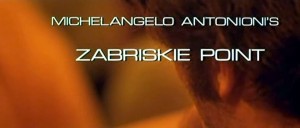 Here’s the idea behind “A Canadian, an American, a Lawyer, and an Elitist”: Rhett’s favorite movie is Meatballs 4, Shawn has an unhealthy fixation on Resident Evil, Richard scoffs at anything that isn’t pretentious and hoity toity, and Adam is a prick who hates everything. We all watch far too many movies, and spend our time analyzing them. So we each watch the same movie, write our analysis of them, and then go to a chat room to discuss it, unaware of what the others have written. A warning: if you haven’t seen the film we are discussing, it may not be best to read this article, because it is spoiler heavy.
Here’s the idea behind “A Canadian, an American, a Lawyer, and an Elitist”: Rhett’s favorite movie is Meatballs 4, Shawn has an unhealthy fixation on Resident Evil, Richard scoffs at anything that isn’t pretentious and hoity toity, and Adam is a prick who hates everything. We all watch far too many movies, and spend our time analyzing them. So we each watch the same movie, write our analysis of them, and then go to a chat room to discuss it, unaware of what the others have written. A warning: if you haven’t seen the film we are discussing, it may not be best to read this article, because it is spoiler heavy.
Analysis by a Canadian: Rhett Miller
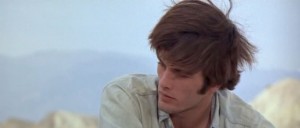 During the documentary Easy Rider: Shaking the Cage, Peter Fonda talks about how the final shot in Easy Rider was to symbolize two conflicting worlds. As the camera pulls back, it reveals a road seeped in flame on one side, and a peaceful river on the other. These two pathways, Fonda says, are to represent the difference between man and nature, young and old, freedom and repression, all in one. Up until that point, Easy Rider is far less subtle in dealing with the culture clash between hippies and repressed society, making this clash visually obvious after repeated scenes of altercation. Zabriskie Point, a film made a year after Rider was released, is also a film that documents this clash between the young and the old, covering similar thematic territory to Dennis Hopper’s monumental film. It is less indebted to Easy Rider as a whole though, than it is to the final shot. It is as if Director Michelangelo Antonioni saw the final shot of Easy Rider, having perhaps missed the rest, and expanded it into a feature film.
During the documentary Easy Rider: Shaking the Cage, Peter Fonda talks about how the final shot in Easy Rider was to symbolize two conflicting worlds. As the camera pulls back, it reveals a road seeped in flame on one side, and a peaceful river on the other. These two pathways, Fonda says, are to represent the difference between man and nature, young and old, freedom and repression, all in one. Up until that point, Easy Rider is far less subtle in dealing with the culture clash between hippies and repressed society, making this clash visually obvious after repeated scenes of altercation. Zabriskie Point, a film made a year after Rider was released, is also a film that documents this clash between the young and the old, covering similar thematic territory to Dennis Hopper’s monumental film. It is less indebted to Easy Rider as a whole though, than it is to the final shot. It is as if Director Michelangelo Antonioni saw the final shot of Easy Rider, having perhaps missed the rest, and expanded it into a feature film.
Zabriskie Point, as its name would suggest, is a film inspired by architecture, locations, environments. It never zeroes in on character like a traditional narrative would, but instead how these characters exist within their environment. Whereas the name Easy Rider describes a person, Zabriskie Point describes a place, and Antonioni examines the counterculture from a similarly distanced perspective. Like the river-road metaphor in Easy Rider, Antonioni splits his entire film into two distinct locations: the capitalistic malaise of advertisements and unrest in the big city, and the undisturbed and unkempt freedom behind the peaks and valleys in Death Valley. It is in these two locations that Antonioni defines the essence of the whole counter-cultural moment sweeping America at the time.
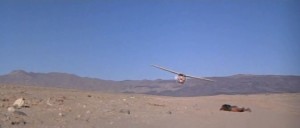 The city is presented as one of moral emptiness, where people do not think, but instead are lead by fashion and by capitalism. The film’s protagonist (or the closest thing to one, anyway), Mark (Mark Frechette), is literally lost during a drive, when advertisements and bulletin boards literally entrap him from all directions. Man is forced to define themselves by the landscape of consumerism, and what products they want rather than what values they actually believe in. He is unable to think, he is unable to feel, he is only able to inhale all message media smoked his way by capitalism. While such a stance may seem obvious, or even cliché in Hollywood at the time, Antonioni does not simply blame capitalism for all of society’s woes.
The city is presented as one of moral emptiness, where people do not think, but instead are lead by fashion and by capitalism. The film’s protagonist (or the closest thing to one, anyway), Mark (Mark Frechette), is literally lost during a drive, when advertisements and bulletin boards literally entrap him from all directions. Man is forced to define themselves by the landscape of consumerism, and what products they want rather than what values they actually believe in. He is unable to think, he is unable to feel, he is only able to inhale all message media smoked his way by capitalism. While such a stance may seem obvious, or even cliché in Hollywood at the time, Antonioni does not simply blame capitalism for all of society’s woes.
The youth are equally as corrupt as capitalism in the big city, their “fight the system!” morals more of a posh trend than one with actual meaning. This is pointed out by a perceptive debate at the start of the picture, where a black revolutionary student condemns his white counterculture peers, in stating that they have no absolute need to rebel, that they just do it for fun. The proletariat needed to take down the bourgeoisie in order to survive, just as the blacks needed to stand up against the institutions if they were to be able to coexist in WASP America. There is urgency to the civil rights activities partaken by the African Americans of the time. They did it to survive, whereas the rest of hippie youth culture were doing it because they could, because it was fashionable. The protests, the violence, everything, stems from the inescapable decay of the big city. People are closed in together so tightly, yet so tightly closed minded, that they all become mere sheep. When a police officer is killed at a protest, Mark takes it upon himself to finally escape the big city. He steals a plane and gets lost in the sky.
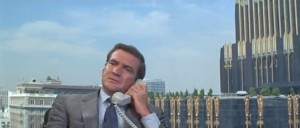 His destination is the second location of the film, and the one mentioned in the title. At Zabriskie Point he meets Daria (Daria Halprin), and the two embark on an odyssey of self-exploration. In all the clutter of the city, the two were never able to free themselves from capitalist repression, but in the desert, where they are surrounded by nothing but horizon, they are finally able to breathe. They talk of nature, relating it to the body, particularly when Daria speaks of a plant and her wanting to grow her own thoughts. This notion of man and nature combining is one that Antonioni explores best during the film’s infamous desert orgy. The scene begins with Mark and Daria in embrace, kissing and freeing their sexual desires. They then begin to contort themselves in various positions of embrace, and they are soon joined by legions of other flower children, as each one makes love passionately on the hot desert sand. What is most interesting is the way that this scene is shot, with Antonioni framing much of the scene in abstract close-up, where the contortions of the body converge with the hills and valleys of the desert landscape. The lovers literally become one with their environment, melding with the unmined beauty of the world. In the city, man was always cast against the billboards and against his environment, but in Death Valley, with its open freedom, he converges with his environment.
His destination is the second location of the film, and the one mentioned in the title. At Zabriskie Point he meets Daria (Daria Halprin), and the two embark on an odyssey of self-exploration. In all the clutter of the city, the two were never able to free themselves from capitalist repression, but in the desert, where they are surrounded by nothing but horizon, they are finally able to breathe. They talk of nature, relating it to the body, particularly when Daria speaks of a plant and her wanting to grow her own thoughts. This notion of man and nature combining is one that Antonioni explores best during the film’s infamous desert orgy. The scene begins with Mark and Daria in embrace, kissing and freeing their sexual desires. They then begin to contort themselves in various positions of embrace, and they are soon joined by legions of other flower children, as each one makes love passionately on the hot desert sand. What is most interesting is the way that this scene is shot, with Antonioni framing much of the scene in abstract close-up, where the contortions of the body converge with the hills and valleys of the desert landscape. The lovers literally become one with their environment, melding with the unmined beauty of the world. In the city, man was always cast against the billboards and against his environment, but in Death Valley, with its open freedom, he converges with his environment.
 Antonioni achieves something beautiful in the way he frames man within the vastness of Death Valley. The way these children merge with the desert landscape seems so natural, like that is the way that man was always meant to be. The whole scenario is much more optimistic than the failed communes displayed in Easy Rider. Antonioni suggests a Rousseauian return to nature, where capitalism and bureaucracy have not yet destroyed the life force. When Daria is brought back to her home, where her father discusses plans to expand his commercial exploits into the desert, she envisions a destruction of all the things she had been trying to escape. In a fantastic montage, featuring a building exploding from countless different angles, all the pitfalls of capitalism, industrialization and corrupted education are destroyed in one glorious vision. The walls of big business, the chairs of the idle bourgeoisie and the books of flawed university teachings are all obliterated as Daria looks on, hoping at starting a new life. She gets in her car and drives away, returning back to the valley where the sun melds with the untouched earth.
Antonioni achieves something beautiful in the way he frames man within the vastness of Death Valley. The way these children merge with the desert landscape seems so natural, like that is the way that man was always meant to be. The whole scenario is much more optimistic than the failed communes displayed in Easy Rider. Antonioni suggests a Rousseauian return to nature, where capitalism and bureaucracy have not yet destroyed the life force. When Daria is brought back to her home, where her father discusses plans to expand his commercial exploits into the desert, she envisions a destruction of all the things she had been trying to escape. In a fantastic montage, featuring a building exploding from countless different angles, all the pitfalls of capitalism, industrialization and corrupted education are destroyed in one glorious vision. The walls of big business, the chairs of the idle bourgeoisie and the books of flawed university teachings are all obliterated as Daria looks on, hoping at starting a new life. She gets in her car and drives away, returning back to the valley where the sun melds with the untouched earth.
 With the final shot of the sunset, Antonioni confirms his preoccupation with landscapes. Man is a product of his environment, Antonioni would say, and this theme is as present in Zabriskie Point as it is in all of his works. Jack Nicholson’s character is unable to escape the barren desolation of the desert in The Passenger, the married couple in La Notte literally disappear behind a tree in the final shot, and most memorably of all, the main characters disappear altogether in the finale for L’Eclisse as the film concludes on a montage of city architecture. What Antonioni does differently in Zabriskie though, is that he chose his actors precisely from an architectural standpoint. Halprin and Frechette were never actors, and they prove that with their limp line readings and forced emotion. What they did have though, was the look of youth, the bodies and faces of an entire generation, and in casting them for their physicality over their talents, Antononioni has done the greatest achievement in creating a total architectural vision in Zabriskie Point. The two lovers were natural, handpicked from their environment and more in touch with the landscapes and the lifestyles of their characters than any trained actors could ever be.
With the final shot of the sunset, Antonioni confirms his preoccupation with landscapes. Man is a product of his environment, Antonioni would say, and this theme is as present in Zabriskie Point as it is in all of his works. Jack Nicholson’s character is unable to escape the barren desolation of the desert in The Passenger, the married couple in La Notte literally disappear behind a tree in the final shot, and most memorably of all, the main characters disappear altogether in the finale for L’Eclisse as the film concludes on a montage of city architecture. What Antonioni does differently in Zabriskie though, is that he chose his actors precisely from an architectural standpoint. Halprin and Frechette were never actors, and they prove that with their limp line readings and forced emotion. What they did have though, was the look of youth, the bodies and faces of an entire generation, and in casting them for their physicality over their talents, Antononioni has done the greatest achievement in creating a total architectural vision in Zabriskie Point. The two lovers were natural, handpicked from their environment and more in touch with the landscapes and the lifestyles of their characters than any trained actors could ever be.
Zabriskie Point is a lot of things: a box office flop, a critical bomb, anti-American propaganda, but above all else, it is an underappreciated artistic statement by one of cinema’s greatest auteurs. It was never accepted by counter-cultural audiences upon release, but hopefully time has made those people realize that this was their generation’s greatest tribute.
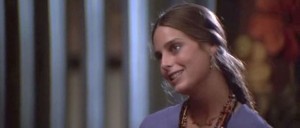 Analysis by an American: Shawn McLoughlin
Analysis by an American: Shawn McLoughlin
Critic darling that he is, I can’t say that I have ever found myself overly impressed with an Antonioni film. It is true that on a visual level he is a mastermind. Everything is perfectly framed and set up. If he lived several hundred years earlier, he probably would have been a painter alongside Michelangelo on a technical scale. But even with this mastery I have never found myself interested in his characters. That, combined with the empty mood and lack of dialog can only engage for so long. A lot of this is different for Zabriskie Point, but in the wrong way for a poor result.
The opening act has more dialogue in the first ten minutes than all of the other Antonioni films I have seen combined. At first this was a refreshing change of pace, and an interesting semi-documentary of the movements of the time. Black militants meet with white potential revolutionaries who are planning a protest to bring a college’s functions to a halt. The protagonist really has no involvement or participation though. He observes, gets bored with the discussion, and leaves. He is treated unfairly by the police who arrest him for no reason. When asked his name and he replies “Karl Marx” which makes one wonder if he agrees with Marx’s approach, or if he just said it for effect. Later he decides to join the escapades again for no apparent reason, and possibly-maybe-kinda-might have killed a police officer. This is an almost-interesting set-up that is mostly ignored for the rest of the film.
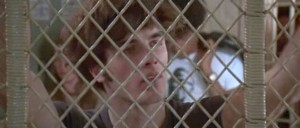 The second act might as well have been directed by Warhol. It becomes silly, unbelievable, and high camp. Particularly amusing is the scene where Mark and Daria make love at the titular Zabriskie Point. Showing them frolicking about in the sand while we are treated to overlays of other couples doing the exact same thing. Assuming that this is meant to show the freedom of youth, it feels an odd clash for a character who twenty minutes earlier thought he may have killed a cop. Daria is much more believable in her role, but as expected in an Antonioni film, never developed. The whole act seems to be a spiritual brother to Easy Rider. Easy Rider was made by an American director to have European sensibilities whereas Zabriskie is just the opposite. At least the characters in Easy Rider have a loose purpose though. They are free, but still have a destination and the drive to get there. Here, Mark simply drifts; there is nothing else to him.
The second act might as well have been directed by Warhol. It becomes silly, unbelievable, and high camp. Particularly amusing is the scene where Mark and Daria make love at the titular Zabriskie Point. Showing them frolicking about in the sand while we are treated to overlays of other couples doing the exact same thing. Assuming that this is meant to show the freedom of youth, it feels an odd clash for a character who twenty minutes earlier thought he may have killed a cop. Daria is much more believable in her role, but as expected in an Antonioni film, never developed. The whole act seems to be a spiritual brother to Easy Rider. Easy Rider was made by an American director to have European sensibilities whereas Zabriskie is just the opposite. At least the characters in Easy Rider have a loose purpose though. They are free, but still have a destination and the drive to get there. Here, Mark simply drifts; there is nothing else to him.
The third act is probably the true anti-American part of the film. It illustrates the cruelty of the justice system by having Mark gunned down brutally and unnecessarily. It makes its anti-Capitalism stance again by painting the plane with various hippie sayings. Daria does this also by imagining her boyfriend’s home and other worldly possessions being blown to bits slowly played out over a Pink Floyd soundtrack in an obvious attempt to attract an audience. (This is probably the most odd, since Antonioni has never been a big fan of music scores, particularly soundtracks.) Ultimately, its tragic conclusion undermines the film by sending the wrong message. The heroes are without victory, they are without goals, and the sacrifices they do make are for naught. If I were a peace-loving hippie of the time, I would feel insulted.
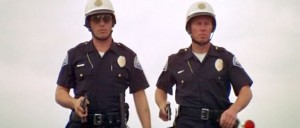 Zabriskie Point is the anti-Antonioni film. It feels nothing like any of his films that I have seen, and seems to ape other films more than become a new one. I give credit for making a film that does attempt to capture the situations of it’s time by using actual activists and having the main characters keep their real names. Kathleen Cleaver, then member of the SDS, plays herself in the opening scenes. The main star Mark Frechette apparently gave the $60,000 he made off this film to give to a commune, and Daria Halprin was briefly married to another counter-culture hero Dennis Hopper of the previously mentioned Easy Rider. So with them all being real youths of the time, dealing with real events of the time, one can only blame Antonioni for allowing the film to become as unrealistic as possible.
Zabriskie Point is the anti-Antonioni film. It feels nothing like any of his films that I have seen, and seems to ape other films more than become a new one. I give credit for making a film that does attempt to capture the situations of it’s time by using actual activists and having the main characters keep their real names. Kathleen Cleaver, then member of the SDS, plays herself in the opening scenes. The main star Mark Frechette apparently gave the $60,000 he made off this film to give to a commune, and Daria Halprin was briefly married to another counter-culture hero Dennis Hopper of the previously mentioned Easy Rider. So with them all being real youths of the time, dealing with real events of the time, one can only blame Antonioni for allowing the film to become as unrealistic as possible.
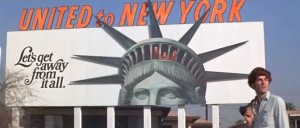 Analysis by a lawyer: Richard Stracke
Analysis by a lawyer: Richard Stracke
Zabriskie Point is a frustrating film. For every moment of genius there are ten minutes of tedium or laughable dialogue. Although narrative has never been a hallmark of Michelangelo’s style, ZP finds him presenting a story that is nearly impossible to care about. His earlier film targeted the European idle class and its frivolity. Here, he turns his attention to American consumerism and disillusioned youth. What could have been a fascinating time capsule film (as Blow Up is for Mod London) quickly turns into a nearly unwatchable spattering of leftist rhetoric and hippie cliché.
Being a fan of Antonioni’s Italian films (even the lesser known Il Grido) I wondered what went wrong. For the most part, I place the blame on the leads. The trilogy features nuanced performances from some of the shining stars of 60s art cinema- Marcello Mastroianni, Jeanne Moreau, Alain Delon and last but not least, Antonioni’s muse- Monica Vitti. These characters are supported by other, lesser known stars such as Ferzetti and Lea Masala. Now, take ZP‘s leads. Mark Frechette may have been pretty, but he could barely read a line of dialogue. Rumor has it that Antonioni discovered him ranting at a bus stop. He was twenty and “he hates”. This may have been great in theory, but his presence nearly killed the film. The same goes for his co-star and purported real life lover. She may have the look that Antonioni desired, but acting is atrocious.
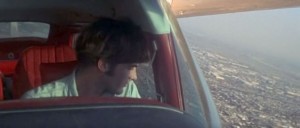 Although the film can’t be faulted for its era, those who know me are well aware that I’m more sympathetic for ennui ridden aristocrats than I am of wanna-be revolutionaries. The film’s early scenes, with their riots and chaos may have been the reality of the times, but the rhetoric and meandering manner with which they were handled are no longer engaging. It’s not that the ideas are ‘frightening’. They’re simply tired remnants of a period that holds almost no interest to me. Along those lines, the film’s message is difficult to discern. The amazing images in the final moments make the disdain for capitalist excess immediately apparent, but if Antonioni were really attempting to sway our opinion, he would have been better off at least trying to make his leads charismatic. This opens another option- that he was so disgusted with the idea of “AMERICA” in general, that he wanted to paint everyone as vapidly as possible. While, to a large extent I would agree with his feelings of disgust, this message isn’t successful either. The lead couple and their struggles are simply too boring to care about.
Although the film can’t be faulted for its era, those who know me are well aware that I’m more sympathetic for ennui ridden aristocrats than I am of wanna-be revolutionaries. The film’s early scenes, with their riots and chaos may have been the reality of the times, but the rhetoric and meandering manner with which they were handled are no longer engaging. It’s not that the ideas are ‘frightening’. They’re simply tired remnants of a period that holds almost no interest to me. Along those lines, the film’s message is difficult to discern. The amazing images in the final moments make the disdain for capitalist excess immediately apparent, but if Antonioni were really attempting to sway our opinion, he would have been better off at least trying to make his leads charismatic. This opens another option- that he was so disgusted with the idea of “AMERICA” in general, that he wanted to paint everyone as vapidly as possible. While, to a large extent I would agree with his feelings of disgust, this message isn’t successful either. The lead couple and their struggles are simply too boring to care about.
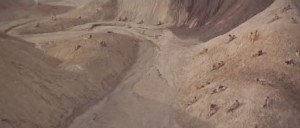 Given the failure of the film’s leads and its message, does it have any strengths? Fortunately, there are moments when Antonioni’s fantastic visuals shine through. First is the “commercial scene”. Second is the Death Valley sequence. Third is the mindblowing ending. Interestingly, apart from the jaw dropping (Gerry and Twentynine Palms must have been influenced) photography, the DV sequence was one of the silliest of the film. To my delight, the banal dialogue was drowned out by the mesmerizing scenery. I was also interested to note how the film influenced The Smashing Pumpkins’ “Today” video- a hallmark of my youth. I wasn’t so interested in the imagined orgy, but in the barren plains that surrounded the leads. The scene was a detour from the lackluster plot, but that’s why it stands out. Apart from the laughable airplane sequence, there isn’t much to connect the few joyful moments in the desert with the rest of the film. It all falls apart once the imagined couples appear, but for a few brief minutes, I experienced a visual masterpiece.
Given the failure of the film’s leads and its message, does it have any strengths? Fortunately, there are moments when Antonioni’s fantastic visuals shine through. First is the “commercial scene”. Second is the Death Valley sequence. Third is the mindblowing ending. Interestingly, apart from the jaw dropping (Gerry and Twentynine Palms must have been influenced) photography, the DV sequence was one of the silliest of the film. To my delight, the banal dialogue was drowned out by the mesmerizing scenery. I was also interested to note how the film influenced The Smashing Pumpkins’ “Today” video- a hallmark of my youth. I wasn’t so interested in the imagined orgy, but in the barren plains that surrounded the leads. The scene was a detour from the lackluster plot, but that’s why it stands out. Apart from the laughable airplane sequence, there isn’t much to connect the few joyful moments in the desert with the rest of the film. It all falls apart once the imagined couples appear, but for a few brief minutes, I experienced a visual masterpiece.
 As I mentioned above, the images of the film’s final moments were spectacular. Although I don’t agree with the politics (that poor rack of clothes deserved to be worn and not incinerated), I was in awe of the shots. They made the film worth seeing and will likely stay with me long after the rest of it fades from my memory.
As I mentioned above, the images of the film’s final moments were spectacular. Although I don’t agree with the politics (that poor rack of clothes deserved to be worn and not incinerated), I was in awe of the shots. They made the film worth seeing and will likely stay with me long after the rest of it fades from my memory.
In conclusion, this is a definite misstep from one of my favorite directors. It would be an unwise first foray into the world of Antonioni. Even for the devoted, it can be a difficult trudge, but its high points justify at least one viewing.
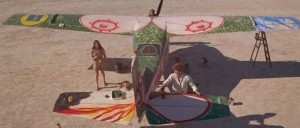 Analysis by an elitist: Adam Lippe
Analysis by an elitist: Adam Lippe
In the late 1960’s, the studios, lost as how to regain the youth audience after the standbys of expensive musicals (Star!, Dr. Dolittle, Hello, Dolly), westerns, and musical westerns (Paint Your Wagon) failed. With no knowledge on how to connect to the hippies and war protestors (such as the drug film by a major director with big stars, Skidoo), and flummoxed by the success of surrealism and anti-establishment films such as Easy Rider, they were no doubt delighted to gain the cache of a name like Michelangelo Antonioni, a serious art director who could get across a message that would “speak” to the masses and bring in the desired box office. The meetings must have been both desperate and enthusiastic.
MGM exec: “We need sumthin,’ ya know,’ the young people will enjoy.”
Michelangelo Antonioni: “Jes. Well, I have some ideas. I know, I understand what you are saying. I think I see the point. What you are trying to do.”
MGM exec: “We want political, but not too reactionary. Ya know? A message, but sumthin’ that speaks to everyone, no matter which side they on.”
 MA: “I see the, the, American flag. And I want to film it. Show all of its sides. All of its people. The young people especially. Their bodies writhing, writhing, in the sand. An orgy of peoples, wide canvas. The American flag.”
MA: “I see the, the, American flag. And I want to film it. Show all of its sides. All of its people. The young people especially. Their bodies writhing, writhing, in the sand. An orgy of peoples, wide canvas. The American flag.”
MGM exec: “Yeah, yeah. Sand. Naked bodies.”
MA: “I see the plane, showing all of the evil and the beauties of the country. The violence, yes, too. The rioting. With the black people. And the white people fighting.”
MGM exec: “Fighting together! Yes!”
MA: “And the business, and the older people, they no understand. They in their big office, ruling over the world. They don’t understand the young peoples. They know not what they fighting for. The revolutionaries, they fight for their freedom. And they understand the struggle. The strife.”
MGM exec, nodding his head in confusion: “Yes, ya got it. I’m with ya!”
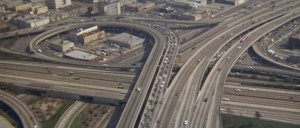 There is a famous quote by Peter Fonda, on the success of Easy Rider, saying that after it became clear the movie was a hit, “the Columbia executives stopped shaking their heads in incomprehension and began nodding their heads in incomprehension.” This was no doubt how MGM felt about Zabriskie Point, which plays like Antonioni’s big joke on them for trying to pander to an audience they didn’t understand. The story is random at every turn. It doesn’t really matter that it begins at a meeting attempting to start a revolt at a college. We don’t know what the militants want, or who they specifically are fighting against. They’re just angry, and they spout platitudes about being held back for hundreds of years. The whites present, want to co-opt their anger, and claim they can understand the frustration with whomever they have their issues with. But the scene is so vague it is impossible to gather anything from it other than that these people aren’t organized. When one of the black militants is killed later on, one doesn’t really relate. It just seems like an attempt, further made clear later on when a character is arrested for trying to find out how to bail out his friend, to show all the police as corrupt over-reactors, serving “the man” to hold back the youth. Since these sequences have no relation to anything that follows, other than to set up show Mark as a drifter, not able to connect to a cause, it can only be construed that they, like the “psychedelic” credits, were suggestions made to “show them peoples what we know they like.”
There is a famous quote by Peter Fonda, on the success of Easy Rider, saying that after it became clear the movie was a hit, “the Columbia executives stopped shaking their heads in incomprehension and began nodding their heads in incomprehension.” This was no doubt how MGM felt about Zabriskie Point, which plays like Antonioni’s big joke on them for trying to pander to an audience they didn’t understand. The story is random at every turn. It doesn’t really matter that it begins at a meeting attempting to start a revolt at a college. We don’t know what the militants want, or who they specifically are fighting against. They’re just angry, and they spout platitudes about being held back for hundreds of years. The whites present, want to co-opt their anger, and claim they can understand the frustration with whomever they have their issues with. But the scene is so vague it is impossible to gather anything from it other than that these people aren’t organized. When one of the black militants is killed later on, one doesn’t really relate. It just seems like an attempt, further made clear later on when a character is arrested for trying to find out how to bail out his friend, to show all the police as corrupt over-reactors, serving “the man” to hold back the youth. Since these sequences have no relation to anything that follows, other than to set up show Mark as a drifter, not able to connect to a cause, it can only be construed that they, like the “psychedelic” credits, were suggestions made to “show them peoples what we know they like.”
The music, Pink Floyd, The Grateful Dead, The Rolling Stones, was probably purchased to cater further to the counter-culture audience, and it is randomly and forgettably slapped on to scene after scene, as the obvious necessity it was.
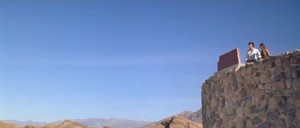 The camerawork is the typical 70’s soft focus zoom frenzy, ponderous, contrasting stiff office interiors with the wide open spaces of the deserts of Arizona to show the “beauty of America.” The dialogue plays so calculatedly aimless (“It’d be nice if they could plant memories in our head. Nice things.”), with Daria even answering her own questions to show her depth (“What do you mean ‘reality trip?’ Oh, yeah.”) and sloppily profane (when the kids ask Daria “may we have a piece of ass?”), the conclusion so determined to give us the idea that things would be so much better if they blew up the establishment (or at least inspire some Fatboy Slim videos), the orgy so slapped in as pseudo-surrealist symbolism, but really filling a nudity quota, that it would be fair to call Zabriskie Point the most contemptuous studio movie ever made. Perhaps it was shelved to shield the embarrassment of revealing too much, all the tricks of the trade on display. If any of Antonioni’s films showed a modicum of humor, it would be fair to suggest that he was in on the joke, a movie supposed to be aimed at America, but really about the cynical nature of Hollywood studios who have no idea how to make an honest film aimed at a younger audience.
The camerawork is the typical 70’s soft focus zoom frenzy, ponderous, contrasting stiff office interiors with the wide open spaces of the deserts of Arizona to show the “beauty of America.” The dialogue plays so calculatedly aimless (“It’d be nice if they could plant memories in our head. Nice things.”), with Daria even answering her own questions to show her depth (“What do you mean ‘reality trip?’ Oh, yeah.”) and sloppily profane (when the kids ask Daria “may we have a piece of ass?”), the conclusion so determined to give us the idea that things would be so much better if they blew up the establishment (or at least inspire some Fatboy Slim videos), the orgy so slapped in as pseudo-surrealist symbolism, but really filling a nudity quota, that it would be fair to call Zabriskie Point the most contemptuous studio movie ever made. Perhaps it was shelved to shield the embarrassment of revealing too much, all the tricks of the trade on display. If any of Antonioni’s films showed a modicum of humor, it would be fair to suggest that he was in on the joke, a movie supposed to be aimed at America, but really about the cynical nature of Hollywood studios who have no idea how to make an honest film aimed at a younger audience.
“Yeah, yeah. That’s it!”
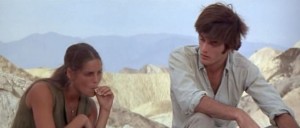 The Chat:
The Chat:
Richard I found this link earlier tonight- It discusses the life of the movie’s star, Mark Frechette, and how he died in prison after being convicted of robbing a bank. Apparently he was crushed to death by a weight while he was lifting.
Adam Are we sure he wasn’t crushed to death during the orgy in Zabriskie Point, during the, no doubt, deathly, penis-in-mouth scene?
Shawn I read a little about the Mark’s life today too. I call foul play. And the prisoner that murdered him hated this movie. Motive!
Richard Motive doesn’t matter if the other con had the requisite intent- and you can get that in a matter of seconds. But it helps.
Shawn “An autopsy revealed he had died of asphyxiation and the official explanation is that the weights slipped from his hands while he was trying to bench press them, killing him instantly.” How can you asphyxiate instantly? Don’t you need at least 30 seconds to a minute? A more reasonable explanation would be the bar slipped, and he broke his neck, thus making him paralyzed and unable to move the bar. Because I have a hard time believing that he couldn’t push back a 150lb bar. If he couldn’t, then he was more of a pussy than he was in Zabriskie.
Rhett Soanyway, should it be one word?
Adam Here’s what I want to know, how much more vacuous would Daria have been had she started talking after she was spinning around?
Rhett Not much more. Whenever she spoke it was the worst part of the movie.
Adam The only way the movie could have been better, is if they had integrated some more of those awesome see-through M*A*S*H* style helicopters
Shawn Okay, show of hands… Whenever we have sex, we imagine other people having sex too, in similar circumstances? ::raises hand::
Richard ::raises both hands::
Rhett :raises his penis: … I think Frechette did do quite a good job, even if Daria Halprin did not. I think it was an interesting experiment though, bringing two unknowns into the lead roles, in true neorealist fashion.
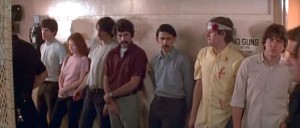 Richard Rhett- I did admire the idea behind the technique, but I don’t think that using non-actors made some of the scenes any less painful. The banality- especially from Daria, really got to me… Painful may have been too harsh.
Richard Rhett- I did admire the idea behind the technique, but I don’t think that using non-actors made some of the scenes any less painful. The banality- especially from Daria, really got to me… Painful may have been too harsh.
Rhett Honestly, I was expecting to see a lot more embarrassing piece of work than I witnessed. Yes, Daria was an empty character, but as I argued in my essay that she was chosen merely to be another piece of architecture, since that is ultimately what matters in Antonioni movies.
Adam Daria wasn’t the only empty character. So was Mark. So were the militants. And the adults. The only thing not empty was the port-a-potty, which is an ingenious place to hide, I must say.
Shawn ZP doesn’t even feel like an Antonioni film. Characters that won’t shut the hell up. Unlike Antonioni. A huge score? Unlike Antonioni.
Rhett Regarding the music, it still basically stuck with Antonioni’s belief that music in a picture should only be that what the characters can hear… I thought the debate in the first scene was an enlightening one, and it was relatively quiet afterwards.
Adam But, in the first scene what were they arguing about? What was their goal? Who were they against? What was their main issue? They said they were being held back, but by whom? Other than “the man.”
Richard I was just about to say ‘the man’, so I assume that’s it. Or, it could be that rack of clothes that goes up in smoke at the end.
Rhett Well, I think it was Antonioni’s way of saying that the whole countercultural revolution was just a fashionable one, where white people used it to be cool, whereas the blacks had true life preservation motivations behind it.
Adam The members of the revolution talk like they’ve never had anything happen to them, and need to feel oppressed. Why are we to sympathize with them when they get killed?
Shawn Well those weren’t actors. Kathleen Cleaver was a leader of the The Weather Underground.
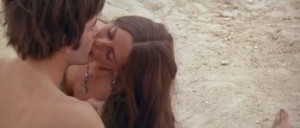 Adam Rhett, I’m talking about the black characters too. Then you could lose all that stuff at the beginning. The fake shooting by Mark is a dead end anyway.
Adam Rhett, I’m talking about the black characters too. Then you could lose all that stuff at the beginning. The fake shooting by Mark is a dead end anyway.
Rhett But you aren’t. Mark escapes that lifestyle because he realizes it is just as bad as everything they are rebelling against. He needs to free himself from the decay of modern society I took the fake shot as Antonioni’s play on our predispositions about the flower children. Naturally, it was assumed that they were a violent threat to society, but in reality, they were harmless.
Shawn Harmless? They were taking a violent strike at society. Homeland Terrorists they were. The Weather Underground arranged bombings and they were certainly a violent threat.
Adam It seemed like we were supposed to believe Mark was an outlaw, but it was a further lie. Why have him show up with an empty gun, point it at a cop, and pretend he killed him and run away? It deflates the story completely to have him be a fake. If he’s a fake, why run away? The bullets wouldn’t match the ones in the cop anyway.
Shawn The first thing I do after I set myself up to look as if I killed a cop is try to haggle a free sandwich.
Rhett Mark couldn’t take the congestion of that city, with its bombardment of capitalist billboards and consumerism.
Richard Getting back to the goal/message of the movie… It was obvious that we were supposed to hate over-indulgent capitalism, but if we were supposed to care or identify with the hippies, why make them so unlikable? Or, are we just supposed to hate everything about ‘modern’ America?
Shawn I think we are supposed to hate The System.
Rhett Well, I found the hippies only unlikable when they were in the city. Given Antonioni’s preoccupation with architecture and environments, i thought that once the people escaped the city they became much more liberated.
Adam The strange part was that the adults are evil, but we don’t even know why, other than they are in a cramped office, discussing money all day and the hippies fuck in the sand. I guess they are equally productive.
Rhett Procreation always beats the greenback. It’s like, nature, mannnnn.
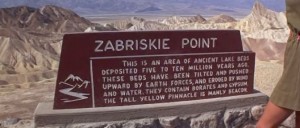 Shawn The adults are trying to take the land away by building on it. Sadly, the “crying Indian scene” is absent from this movie.
Shawn The adults are trying to take the land away by building on it. Sadly, the “crying Indian scene” is absent from this movie.
Rhett The Indian could say he got sand in his eye.
Adam But Shawn, they blew up that miniature at the end from every conceivable angle. Isn’t that enough for you?
Shawn If I don’t see a crying Indian, I cannot feel sympathy.
Rhett That was a miniature?
Adam It would have been very easy shoot as a miniature, and pointlessly expensive as a real building.
Shawn All I saw was a black man get shot, an airplane get stolen, and a perfectly nice wardrobe demolished.
Rhett Well, the explosions are the exact same in every shot, so that would mean they had to rig a number of cameras in a cramped miniature space at the same time to capture it.
Adam Yes, but they do that all the time with miniatures, just zoom in.
Shawn Has anyone else seen the 1971 version of Vanishing Point?
Adam ZP reminded me a lot of Vanishing Point too.
Shawn I want to go on record saying that I enjoyed VP a lot more than ZP. VP is similar, only the characters have reason to be. They have drive. Nothing in ZP, save for The Weather Underground, have any drive.
Rhett No Antonioni characters ever have drive, is that really a criticism? Hemmings gives up on the murder in Blow-up, they give up looking for the girl in L’avventura, Jack Nicholson gives up running in The Passenger.
Adam Rhett, a character needs to have a goal for us to care or show interest in them. If you don’t have drive, why would we want to see a movie about you?
Rhett To show how man has been hollowed by modernity.
Richard None of Antonioni characters ever care, but normally I stay very interested. In ZP’s case I think it was either due to their increased thespian skills or the fact that I can’t identify with hippies.
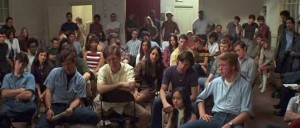 Rhett The cinematography alone in his movies is reason enough to keep watching Antonioni. They are never even really about characters anyway.
Rhett The cinematography alone in his movies is reason enough to keep watching Antonioni. They are never even really about characters anyway.
Shawn But I dislike Antonioni’s films except for the visuals. ZP is OBVIOUSLY about characters though. And when you make a film about characters, and emotions, you need to have feeling. This film lacks feeling. It merely copies from other counter-culture films.
Rhett Well, visually I found ZP to be among Antonioni’s best. Besides, you can’t feel in Antonioni’s universe, that is the point.
Shawn Antonioni has made a film where we are SUPPOSED to feel.
Rhett Why are we supposed to feel?
Richard The visuals (especially the Death Valley stuff) were stunning, but while the typical Antonioni character doesn’t get in the way of the architecture and whatnot, Mark and Daria felt intrusive. It could have been intentional- that even though these two weren’t as bad as the adults- they still sullied nature. But that doesn’t keep them from being a challenge to put up with.
Shawn Compare the films, Rhett, it is easy to disassociate from characters that have no dialogue. Here, there is more dialogue than in every Antonioni film I have seen combined. If we weren’t supposed to feel, have them shut the hell up.
Rhett From the orgy onward the film is pretty damn silent.
Shawn The orgy is more than two-thirds of the way through the movie.
Rhett There is a lot more dialogue in La Notte. And even that was still about how empty the upper class was.
Shawn So this movie is anti-upper class? Like L’avventura, La Notte, and L’eclisse?
Rhett No, I was just saying that even his movies with plenty of dialogue are still about how empty all the characters are.
Shawn So why should I continue to listen after being told the same thing three times? I will quote myself from our Europa chat. “Visual porn.” There is nothing else in ZP worth caring about.
Adam C’mon Rhett, as you have often said about Adam Sandler, if Paul Thomas Anderson hadn’t directed Punch Drunk Love, the critics would have savaged it, and ZP is such a pandering to the counter-culture movie that you wouldn’t give a second thought to it if Antonioni had no involvement.
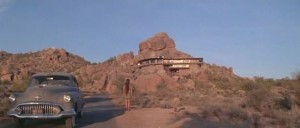 Rhett But the critics did savage ZP, Adam. It’s not like I’m playing the auteur card here, giving Antonioni credit because he has contributed a greater body of work. I thought that he tapped into America at a very important time, and the manner in which he told the story was infinitely different than the rest of counter-culture films that I’ve seen.
Rhett But the critics did savage ZP, Adam. It’s not like I’m playing the auteur card here, giving Antonioni credit because he has contributed a greater body of work. I thought that he tapped into America at a very important time, and the manner in which he told the story was infinitely different than the rest of counter-culture films that I’ve seen.
Shawn I will say I “enjoyed” ZP more then Antonioni’s other movies. But it really doesn’t count when I’m laughing at it. There is nothing at all in ZP about kids, education, freedom, love, and America that wasn’t said much better in Easy Rider, which was made by an American, using European-inspired technique. ZP is exactly the opposite. Europe being American.
Adam There isn’t even a cohesive notion at all. Just arrogant aimlessness.
Rhett Well, sometimes subtlety is a tough thing to appreciate.
Richard Easy Rider I found utterly unwatchable. ZP was much more rewarding- for visuals alone. As far as the characters in ZP go, I can’t reconcile why I love films that bash characters that I feel something for (idle rich) while this, bashes the whole 60s era (that I have no pity for), but I couldn’t care less about much other than the visuals.
Adam Easy Rider is unwatchable. But it’s one of those movies that nailed something at the time, and ZP is obviously a studio exec trying to ape that. “Let’s nail the zeitgeist, and make money too.”
Rhett How was ZP American in anything other than the setting? The film language used, in the photography, cutting, acting, etc, is all still very much European.
Shawn I see very little of Europe here at all, Rhett. I see Antonioni attempting to represent American life. Except as you mentioned, for the last act, which is the only part I would consider Antonioni’s. The rest looks like it could have been spliced from stock footage and limited film by any student filmmaker at the time.
Adam I bet Antonioni delivered exactly what the studio asked for, and like Paul Schrader’s Exorcist IV, they didn’t know what to do with it
Richard ZP really reminds me of Bruno Dumont’s Twentynine Palms. A European director doing his first film in America. Seemingly aimless until a shocking ending comes along that sticks with you.
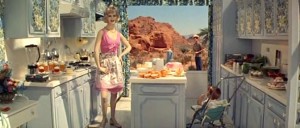 Adam While watching ZP, I thought a lot about Medium Cool, made a year earlier. That movie is dated as well, but it is a real exploration of police activity and riots, not some attempt to co-opt it. And you can see what the revolts are about.
Adam While watching ZP, I thought a lot about Medium Cool, made a year earlier. That movie is dated as well, but it is a real exploration of police activity and riots, not some attempt to co-opt it. And you can see what the revolts are about.
Rhett The notion of capturing real people in real situations for a fictional film, as in all the protesting/debating scenes, is a European technique, Shawn. See Roberto Rossellini, Gillo Pontecorvo, etc. It’s something Antonioni explores a lot in The Passenger too, making the Jack Nicholson character a documentary filmmaker interviewing real life Africans.
Adam Medium Cool used real footage, but ZP didn’t, at least in the riot scenes.
Richard Another thing that irked me about this film… The Italian films use ambiguity to become mysterious. ZP was frustrating and tedious because of the lack of connections. I didn’t understand the motivations. Stealing the plane and such… Her finding him interesting after he ‘terrorized’ her from the sky.
Shawn He obviously wanted to mimic North By Northwest for the hell of it.
Rhett I just took it all as Mark’s need to escape. If the counterculture is all about freedom, there is little in the world freer than the open sky.
Shawn Things to do today: Attend meeting. Leave meeting. Decide to join anyway. Kill cop (or not?). Hustle a sandwich. Steal an airplane. Fuck in the hottest place on Earth. Who says Mark didn’t have goals?
Adam You forgot paint an airplane. And get shot (or not).
Shawn Ah yes, that was inspired, though, not on his agenda.
 Rhett I liked how the movie kind of played with reality. How it wasn’t clear initially whether he had been shot or whether he just was no longer there. Just like it is never clear as to whether or not the house really does blow up or whether or not it is just Daria wishing it was so.
Rhett I liked how the movie kind of played with reality. How it wasn’t clear initially whether he had been shot or whether he just was no longer there. Just like it is never clear as to whether or not the house really does blow up or whether or not it is just Daria wishing it was so.
Shawn I imagined myself in a theatre watching a better movie.
Rhett Like Antitrust.
Shawn Yes, Rhett, like Antitrust. During which I imagined fucking the entire female cast. While Tim Robbins watched.
Adam I thought Mark vanishing might have been a reference to Wonder Woman, except instead of an invisible plane, it was an invisible pilot.
Rhett In a lot of Antonioni’s movies people just disappear. Like the girl in L’avventura and Nicholson in The Passenger.
Adam I think, with the house blowing up, he was just ripping off that Fatboy Slim video… In advance.
Richard I assumed that the blowing up was just imagined. I didn’t imagine her being enough of a go-getter to achieve such a thing. Il Grido is about a man who decides to leave. He wanders the Po Valley aimlessly.
Rhett Maybe without religion, since all of his characters are essentially existentialists, there is nothing to keep them grounded in the universe. They could just disappear and it would never matter.
Shawn I find that a bit of a stretch. I think they just imagine a better world (for them) without actually changing anything. And I rationalize that since I am essentially a pacifist myself.
Rhett I was reading that Antonioni movies are in ways better at showing who the viewers are than who Antonioni really is, since they offer so many vague moments that the critic often ends up bringing more about himself onto the film than Antonioni.
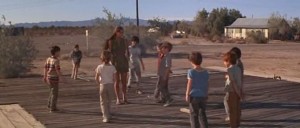 Adam But where is the line between us doing the work he didn’t do, and simply being elliptical? I’ve always felt Coppola had the same problems in his more popular films, especially the first Godfather, people bringing the meanings that haven’t been worked out by Coppola himself. There is the passive viewer who won’t look into anything, then there is us, who look too deeply into something on occasion. Where is the middle?
Adam But where is the line between us doing the work he didn’t do, and simply being elliptical? I’ve always felt Coppola had the same problems in his more popular films, especially the first Godfather, people bringing the meanings that haven’t been worked out by Coppola himself. There is the passive viewer who won’t look into anything, then there is us, who look too deeply into something on occasion. Where is the middle?
Rhett Well, Antonioni is a smart mofo, and there are some books with interviews with him and he is always able to explain every motivation for every scene.
Shawn Seriously though, that is a good question, because I know that I am more lenient then most of our group. I can perfectly enjoy films others don’t and justify why.
Rhett Meatballs 4.
Shawn Exactly. But there are some things I feel there really isn’t a deeper meaning to. I respect Rhett specifically because he seems to find something in everything. And I think that is why Rhett liked ZP so much.
 Richard I was just skimming my Taschen Antonioni book. It argues that ZP loses its documentary substance once it lets the love story takes hold.
Richard I was just skimming my Taschen Antonioni book. It argues that ZP loses its documentary substance once it lets the love story takes hold.
Rhett I thought the documentary stuff had served its purpose at that point though, establishing the values on that particular generation as a whole, so we would have something to transplant onto the thinly developed lovers.
Adam But what kind of love story has two idiots at the center, and isn’t intentionally funny once?
Shawn The Other Sister?
Adam Actually, I would have said Love Story, but Rhett might have had an aneurism.
Rhett Can you blame Daria for falling in love with Mark though, even despite him trying to run her over with a plane? Who wouldn’t want to fuck Karl Marx?
Richard Another point in the book- the film is about how he (as activist) transformed her from pacifist to activist. I can’t agree because he seemed a faux activist and I don’t believe that she actually took action at the end.
Rhett Well, maybe she did turn to an activist, but it wasn’t because he was one. His death perhaps motivated her to consider taking a stand, but more out of vengeful tactics than in believing in the whole counterculture thing.
Adam I couldn’t really understand what was said on the radio so I had to kind of guess that she heard he was dead.
Rhett That was basically all that was said. Then she changed the station to Pink Floyd.
Adam Logical move. That always motivates me to keep driving to my rich daddy’s house on the hill.
Shawn That was her dad?
Adam Wasn’t it?
Shawn I thought that was the older guy she was fucking on the side.
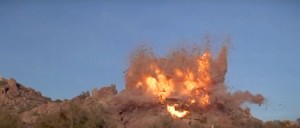 Adam In terms of logistics, I couldn’t tell where anyone was in the offices and the way he hugs her when she gets there, it wasn’t sexual.
Adam In terms of logistics, I couldn’t tell where anyone was in the offices and the way he hugs her when she gets there, it wasn’t sexual.
Rhett I figured it was a parental figure, but I am not sure.
Richard I assumed it was some sugar daddy lover and not biological papa.
Adam And when she calls him from the diner where some mysterious figure is ruining the town, he acts like a dad ok with not being in complete control of his 20 year old daughter, but still slightly uncomfortable with that.
Rhett Yeah, the hug was very non-sexual. But that would be pretty heartless to want to blow up your father, rather than just a sugar daddy.
Adam C’mon Rhett, an activist doesn’t mince actions, she blows up her daddy if she has to.
Richard Interesting background about Daria- she was discovered in an underground documentary called ‘revolution’. Frechette called it a skin flick.
Adam What was the point of those scenes with the kids and the diner? You know, other than to show the middleweight champ of 1920, with no teeth.
Rhett Yeah, they didn’t serve a lot of purpose.
Shawn So her friend apparently took a bunch of kids to Death Valley and deserted them outside a diner? And if they want a piece of ass, they are damn well gonna ask for it.
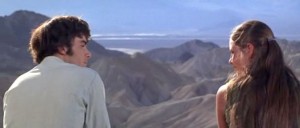 Adam Was that guy supposed to be a Charlie Manson style figure? Or Deepak Chopra?… She was there for yoga, right?
Adam Was that guy supposed to be a Charlie Manson style figure? Or Deepak Chopra?… She was there for yoga, right?
Shawn Or just meditation.
Adam Or to plant memories. You know, nice ones.
Rhett Harrison Ford was there for the pussy.
Richard I was too lazy to look for him. He’s in the jail, right?
Rhett Yeah, you see him when Mark is brought in.
Shawn I have a theory that Ford’s scenes really weren’t cut and that George Lucas went over Antonioni’s head to make “special editions” of ZP.
Rhett The rock formations in Zabriskie Point were made to mimic Jabba the Hutt’s general shape and form.
Richard “Mark: Tell ’em how you got the part. Antonioni saw you in a skin-flick while he was slumming around North Beach …. Daria: It was not a skin flick! It was ART!”
Adam Now that Antonioni is actually making skin flicks, we can see how he got his start in the genre.
Shawn Is he still using empty characters? Because then it would be just like any film school grad porn.
Adam In Beyond the Clouds, there really aren’t people, just Red Shoe Diaries-style pontificating. Same with Eros.
Shawn Does anyone know how Daria and Dennis Hopper met? They were married for several years according to the IMDB.
 Adam He walked up to her and said “may I have a piece of ass?”
Adam He walked up to her and said “may I have a piece of ass?”
Richard I think Hopper was somehow involved with some commune.
Shawn That would make sense Richard… “Chester Crill, the singer, violinist, and keyboard player for Kaleidoscope, remembers all too well the preview screening at which he saw Zabriskie Point. ‘When it was over,’ he says, ‘there wasn’t a person who left that was looking anyone else in the eye. It was the most embarrassing thing that I’d ever been to. Everybody just slunk away.'”… I think I’m going to buy the video game rights for Zabriskie Point, so that Uwe Boll can remake it.



